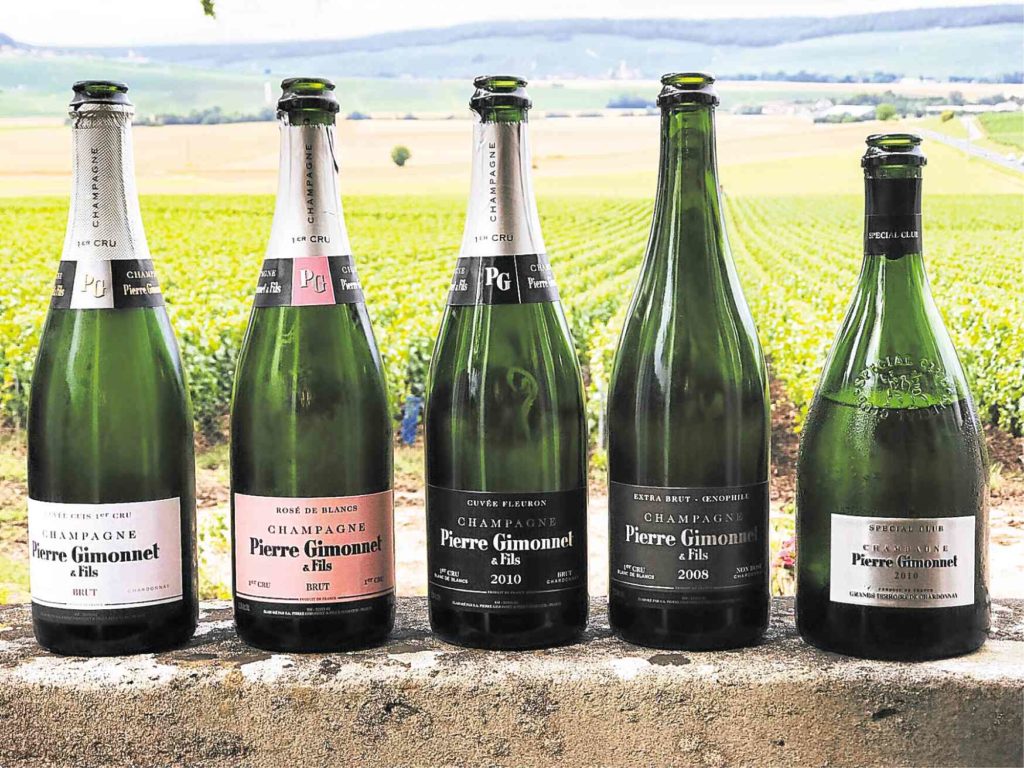Champagne redux

I know I just wrote about champagne last Sunday (featuring Gosset Champagne) but after an afternoon of champagne education from master blender and champagne house owner Didier Gimonnet in Champagne, it would be tragic not to share with you what I have learned.
There is so much more to champagne than just bubbles!
First—and this you may already know—a bubbly can only be called champagne if it actually came from Champagne. In fact, in some countries, it is illegal to label a product Champagne unless it comes from the Champagne region of France and is produced under the rules of the appellation (the district in which a wine bearing an appellation contrôlée is produced). These rules include secondary fermentation of the wine in the bottle to create carbonation, specific vineyard practices, and sourcing of grapes exclusively from specific parcels in the Champagne appellation.
Second, did you know that some grapes used in making champagne are actually red, like pinot noir, a red wine grape variety? That is because once peeled, pinot noir grapes are white inside, hence used for some champagnes, often blended with other white grapes like chardonnay, and a favorite for making rosé.
Third, what grapes are used to make champagne? Champagne is usually a blend of three grapes: Pinot noir, pinot meunier and chardonnay. But when they say that a champagne is blanc de blanc, it means that this was produced with white grapes only, usually 100 percent chardonnay.
Blanc de blanc
The blanc de blanc is arguably the most elegant style of champagne, best made in the Côte des Blancs and Côte de Sézanne, as these are the two subregions where the best chardonnay is grown.
The Côte des Blancs is known for its chardonnay grown in six grand cru villages: Avize, Chouilly, Cramant, Le Mesnil-sur-Oger, Oger and Oiry. A “grand cru village” means that these villages produce the highest quality grapes.
One of the best producers of blanc de blancs is Pierre Gimonnet & Fils, whose champagne house is located in Cuis.
The Gimonnet family has in fact been growing grapes since 1750, supplying the great Champagne houses.
But around the 1930s recession, when sales of grapes fell, Monsieur Pierre Gimonnet, Didier’s grandfather, decided to commercialize his own harvest, and Champagne Gimonnet was born.
Pierre Gimonnet lived to be 93 years old and Didier teased, “You know what was his secret to a long life? He drank a bottle of champagne every day!”
Côte des Blanc
Gimonnet’s champagne is so elegant and pure yet sharp and light that a critic called it “the poster child for the Côte des Blancs”.
Like the best producers of red wine, Gimonnet’s secret is this: It grows its own grapes; while other champagne houses use grapes from various regions, it only uses grapes from Côte des Blanc, particularly those from its own estate.
This has allowed Didier to develop a bond with the land. “I know exactly each plot in the domain … I spend more time in the vineyard because my objective is to produce wine with the expression of the soil,” Didier explained.
With Gimonnet, whether you purchase a vintage blanc de blanc (using grapes from a particular year alone) or a blend from various years, you can expect minerality and complexity amid near weightlessness and purity in every glass.
This beautiful expression of the Cote de Blanc terroir is probably the reason why critic Robert Parker called Pierre Gimonnet & Fils champagne “outstanding”, going as far as declaring it to be one of the top 15 producers in Champagne. That is an exceptional ranking, considering that there are hundreds of producers and champagne houses in the region, with the bigger houses producing almost 3 million bottles annually while Gimonnet only produces nearly 400,000.
How does Didier consistently achieve this quality champagne?
It’s a skill that cannot be learned nor explained.
“I grew up with it,” he concluded. “The style of Gimonnet is in my blood.”
Champagne Pierre Gimonnet & Fils.
1 Rue de la Republique, Cuis, France.
Gimonnet Champagne is distributed in the Philippines by Artisan Cellar Wines. 2276 Pasong Tamo Ext., Makati. For inquiries call landline +63 2 880 0619.
